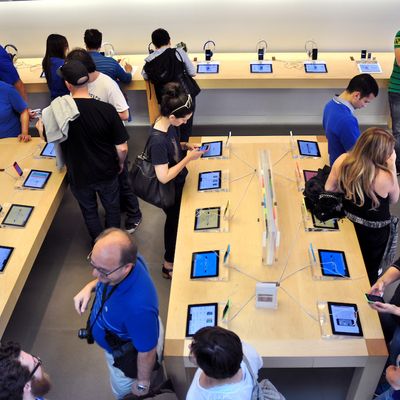
In The Wall Street Journal today, Christopher Mims lays out the increasing amount of money that Apple’s services sector — which encompasses everything from Apple Music to money brought in via the App Store — has been bringing in for the company. Taken by itself, Apple’s services brought in $31.5 billion in revenue last year, enough to make it a Fortune 100 company on its own.
But Apple has fundamentally been a high-end hardware company: It sells you actual (luxury) objects at a very healthy profit margin, rather than subscriptions to services. And the two businesses — high-end hardware versus services — are in opposition to one another. If you opened up the App Store to non-iOS devices, Apple would earn more money from the App Store in the short term, but remove a very compelling reason to own an iPhone. In the Journal, analyst Horace Dediu offers up a way to square that circle — by making hardware itself a subscription:
One way for Apple to resolve the hardware-versus-services tension would be to roll them into one giant subscription, Mr. Dediu says.
Apple already offers an upgrade program, where users can pay off an iPhone after 24 months or trade it for a new one after a year. Imagine a service where you simply subscribe to a regularly updated iPhone, Apple Watch, AirPods or some subset of these devices. Mr. Dediu estimates that for every Mac or iPhone, the average Apple customer spends on average a dollar a day on hardware plus services. A customer would spend more for a premium version — say, for a new MacBook Pro and an iPhone X — but calculating the annual value of such a customer should be straightforward for a company like Apple.
Throw in health monitoring, an iCloud subscription, Apple Music, Apple’s original programming and more into a cable-television-like bundle, or a la carte, and Apple could go from being a hit-driven company to one that throws off predictable, consistent, subscription-based revenue. Think of it as Apple Prime.
There are, of course, parallels to this in other industries. Very few people in the United States buy a car outright anymore — they either lease or get an auto loan, which is essentially a subscription fee that you pay to a bank or dealership. Rent is a subscription plan for housing, with a mortgage acting as the same but with extra fees attached, since you eventually own a home.
Silicon Valley is big on the idea of the “network effect” — the concept that things, whether that’s a search engine or a social network, get better the more things are connected to it. It lies at the heart of many companies’ pursuit of interoperability — that generally it’s better if companies’ products can communicate with each other, because at the end of the day both companies benefit.
Apple may believe in the network effect in the abstract, but it’s become increasingly clear since the launch of the iPhone that the ways it most clearly believes in the network effect is in Apple’s own products. An iPhone by itself is a good phone. An iPhone and an Apple Watch and AirPods and a MacBook Pro and an iPad and an Apple TV and a HomePod and a home outfitted with a few key HomeKit appliances is an extremely compelling constellation of devices, all designed to work together (and only with each other), that no other company can currently match.
Buying all of those devices individually is tremendously expensive. Subscribing to it? That may be something a lot more people would consider.





























